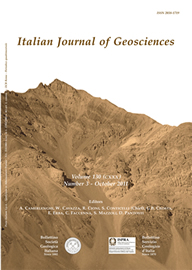
Mixed carbonate-siliclastic sediments and benthic foraminiferal assemblages from Posidonia oceanica seagrass meadows of the central Tyrrhenian continental shelf (Latium, Italy)
Virgilio Frezza(*), Guillem Mateu-Vicens(*) (**), Giovanni Gaglianone(*), Alessio Baldassarre(*) & Marco Brandano(*) (***)
(*) Dipartimento di Scienze della Terra, Sapienza - Università di Roma, Piazzale A. Moro, 5 - 00185 Roma, Italy. Corresponding Author: Virgilio Frezza; Fax +39 06 4454729; E-mail address: virgilio.frezza@uniroma1.it
(**) Current address: Càtedra "Guillem Colom Casasnovas",Edifici Guillem Colom Casasnovas - Universitat de les Illes Balears, Cra. de Valldemossa Km. 7,5 - 07122 Palma de Mallorca, Spain.
(***) Istituto di Geologia Ambientale e Geoingegneria (IGAG) CNR, Area della Ricerca di Roma 1, Via Salaria, Km 29,300 - C.P. 10, 00015 Monterotondo Stazione, Roma, Italy.
Volume: 130 (2011) f.3
Pages: 352-369
Abstract
Sedimentological and micropaleontological characterisation of bottom sediments from two Latium continental platform areas (central Tyrrhenian Sea) was carried out. The two studied areas are Santa Marinella in northern Latium and Ponza Island in southern Latium (Pontine Archipelago), characterised by the presence of Posidonia oceanica seagrass, but with different sediment inputs. In the Santa Marinella area, where seagrass ends at 15 m water depth, there are both siliciclastic sediments from fluvial run-off and carbonate lithoclasts originated by coastal erosion. In the Pontine Archipelago, in which P. oceanica meadows end at 35-40 mwd, terrigenous clasts originate only from coastal erosion and, consequently, carbonate production prevails. On the whole, grain size analysis shows a strong predominance of sandy fraction, whereas mud and gravel are subordinate. The very low frequencies of muddy fraction can be attributable to re-suspension processes and the lack of aragonitic components that produce mud-sized particles. The better sorting of Santa Marinella seagrass substrate with respect to Ponza Island is related to the origin of terrigenous sediments, which are mainly provided by rivers and so are previously sorted. Facies analysis was performed using component analyses, grain size percentage, sorting and carbonate content, complemented with the observations obtained from artificially-hardened sediments and, finally, tested with a Q-mode cluster analysis. Consequently, 4 sedimentary facies have been recognised. Facies F1, limited to the Santa Marinella area (7.5-13.5 mwd), is characterised by sand-sized wellsorted sediments, and dominated by the terrigenous fractions. Facies F2 represents the shallowest seagrass environment (5-7 mwd), and it is restricted to the Ponza area. In this environment the sedimentation is still dominated by terrigenous components, while the carbonate sediment contribution is due principally to red algae. Facies F3 has the widest water depth interval (8-34 mwd), and principally occurs in the Ponza site, while only two samples are from the Santa Marinella. The terrigenous fraction is conspicuous, however there is an increase of carbonate sediment produced mainly by the epiphytes (foraminifera, bryozoans) and, subordinately, by benthic organisms (foraminifera, molluscs). Facies F4, occurring in the Ponza site (17-29 mwd), is the most carbonate rich facies with a carbonate sediment produced by epiphytic (foraminifera, bryozoans, serpulids, red algae) as well as benthic (foraminifera, red algae, molluscs) biota. Q-mode cluster analysis performed on the most abundant benthic foraminiferal species led to the identification of 4 assemblages, dominated by epiphytic foraminifera. The A1 assemblage was found only in the Ponza site (5-12 mwd) and is dominated by Lobatula lobatula, Peneroplis pertusus and Miliolinella subrotunda. The A2 assemblage (10-34.5 mwd), characterised by L. lobatula and Rosalina bradyi, is mainly limited to Ponza Island, with only one sample from Santa Marinella. The B1 (7.5-9 mwd) and B2 (8-13.5 mwd) assemblages were found only in the Santa Marinella area and are dominated by L. lobatula, R. bradyi and Conorbella hexacamerata and by Asterigerinata mamilla and R. bradyi, respectively. The calculated diversity indices (α-Fisher and Shannon index) are very similar in both areas, whereas the dominance percentage is higher in the Santa Marinella site. The lack of the symbiont-bearing foraminifer P. pertusus in the Santa Marinella samples may be linked to less favourable environmental conditions. In this area, the prevalent siliciclastic sedimentation and the water turbidity, which decreases the light penetration, are the limiting factors also for the seagrass growth. The comparison between the foraminiferal assemblages of two areas may be used to estimate the health of present-day and fossil seagrass.
Keywords
Get Full Text Supplementary Material